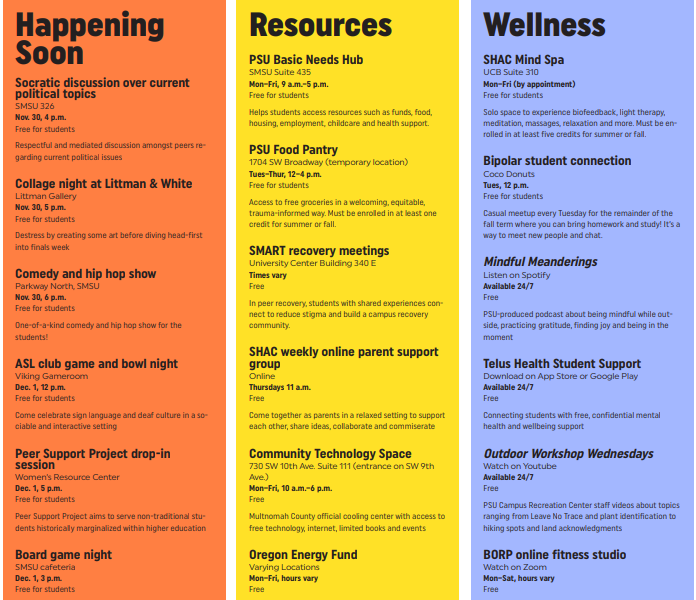If you’ve lived in Portland for a while, you’re probably familiar with the risks associated with residing in this region along the Cascadia Subduction Zone (CSZ)—a fault located 70–100 miles off the Pacific coast. The CSZ increases our vulnerability to 9.0 magnitude or greater earthquakes coequally know by Portlanders as the Big One. However, you may not consider the danger that could arise after a large earthquake when structural instability poses a threat of releasing toxic chemicals.
Luke Hanst, partnership coordinator for the Institute for Sustainable Solutions at Portland State, has recently researched and published a report on the potential of earthquake-induced hazardous materials releases in Multnomah County during the CSZ earthquake.
Hanst’s focus on natural hazard mitigation for the city of Portland evolved into working on the earthquake response plan. “One of the community lifelines FEMA identifies are hazardous material [HAZMAT] facilities, which led us to explore the vulnerabilities and risks associated with them,” Hanst said.
HAZMAT facilities at the Critical Energy Infrastructure Hub (CEI Hub) are a significant concern for Portland regarding the aftermath of Portland’s future CSZ earthquake.
According to the Multnomah County Office of Sustainability, The CEI Hub is a six-mile stretch of industrial development along the west shore of the Willamette river. Facilities in the CEI Hub store more than 90% of all liquid fuel in Oregon.
Various acids, potentially explosive chemicals and toxic inhalation hazards are stored in different container types in facilities across Oregon. If these hazardous materials are released during the CSZ earthquake, it could add to the potential danger.
According to Hanst, prior research from Multnomah County and PSU has described a potential catastrophic scenario stemming from a magnitude 9.0 CSZ earthquake, which could lead to a substantial oil spill of 90–180 million gallons of petrochemical products at the CEI Hub.
Hanst’s work for Multnomah County follows the footsteps of those researchers to also look at the risks of other hazardous facilities which store a variety of acids, potentially explosive chemicals and toxic inhalation hazards like chlorine and anhydrous ammonia housed in a variety of container types. This prompted a year-and-a-half-long venture to assess the risks.
According to Hanst, many developers constructed these facilities before the state implemented crucial code changes. Therefore, these buildings might not meet the necessary seismic design requirements despite their high safety standards.
The report mentions that the proximity of this CEI hub to natural assets—such as the Willamette river, Columbia river and the dense urban core in the city of Portland—make the risk of accident, spill or significant failures due to a seismic event particularly concerning.
Additionally, the impact on environmental resources—including agriculture, fisheries, wildlife and coastal ecosystems—highlights the broader consequences of seismic events. Such a catastrophic release will threaten the health of people who live or work near the CEI Hub with exposure to toxic concentrations of evaporating petrochemicals and further the impact of fires which are likely to start during the earthquake.
These threats would arrive when public response operations are limited and face significant barriers, including widespread infrastructure damage due to the seismic activity. Hanst’s report also noted the lack of post-earthquake emergency plans for HAZMAT facilities—a gap in regulations not unique to Oregon. While these facilities maintain emergency response plans, they may not be viable after an earthquake when transportation and communication infrastructure are damaged.
Addressing long-term impacts, Hanst acknowledged the potential risks to agriculture and the environment. While immediate threats to life safety stem primarily from toxic inhalation hazards, historical examples suggest the possibility of spills causing harm over an extended period. The need for research and concrete plans to mitigate these risks became evident.
In discussing the paper’s direct implications for the PSU campus, Hanst acknowledged the uncertainty, stating that the impact depends on variables—such as wind direction, earthquake magnitude and many other variables—meaning continued research is critical.
While the PSU campus is further from high-risk industrial facilities, the complex nature of potential hazardous releases necessitates coordination with local authorities for comprehensive planning.
Hanst stressed the importance of standard earthquake preparedness across the board. “Being two weeks ready with sufficient water and food stored is crucial,” he said.
The uncertainties surrounding hazardous material releases make it challenging to provide specific guidelines, but if done strategically, sheltering in place could be an option. Folks should educate themselves on shelter-in-place guidelines as well as decontamination guidelines. It is essential to look to Multnomah County and other public agencies for guidance on personal protective actions.
Hanst highlighted the need to support earthquake safety in hazardous material facilities through legislative efforts and community engagement. Engaging with local legislators and joining neighborhood emergency response teams were highlighted as tangible steps for individuals to contribute to preparedness. You can build a safer, more resilient community by staying informed and actively participating in preparedness efforts.
Understanding and preparing for these potential risks becomes essential to living in Portland. Awareness and being proactive in earthquake preparedness ensures everyone a safer and more secure future.






